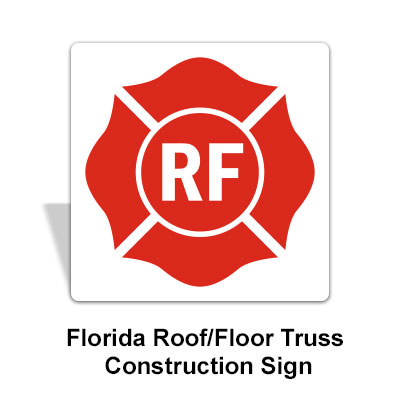Truss Signs Overview
Truss Signs – What are they and where do I need them?

Truss signs are specialized signs that identify buildings that use a truss type construction. Most states that require the posting of truss signs do so for commercial and industrial buildings. A truss sign is an essential tool to firefighters in alerting them to the often unseen construction. Structures using truss type construction can be comprised by fire damage, and the damage could cause a roof, floor, or wall to suddenly collapse.
The location of where a truss sign should be posted should be detailed in your local fire code. You should consult with your local government before purchasing or installing truss signs to ensure that you are ordering the right signs and that they will be compliant with your local fire code.
In New Jersey and Florida, for example, truss signs need to be installed to the left of a building’s main entrance at a height between four and six feet. This differs in New York, where signs can be placed on doors, sidelights, or walls, depending on the sign’s location (e.g. exterior entrance doors, near fire department hose connections).
Why are there different types of truss signs?
All truss signs are basically the same – they all alert fire fighters to the use of truss construction on premise. The designs and certain specifications can differ, though.
Most state and municipal fire codes that specific the use of truss signs require a symbol to identify floor truss construction (“F”), roof truss construction (“R”), and both floor and roof construction (“FR”). Most fire codes also require truss signs to be reflective for greater visibility. Below is an arrangement of various truss signs from across the country.
While the image above displays specific types of truss signs used in six states, there are many more places that have mandated the use of this sign in fire codes.
One example is the city of San Francisco, California. The use of truss signs and the sign’s design is described in the San Francisco Fire Code , and the design matches that of the requirements used in New Jersey. The New Jersey compliant truss sign sold by SafetySign.com is actually compliant under both New Jersey and San Francisco fire code regulations. Information about what type of truss sign you might need should be obtained through your local government.
To see more truss sign designs, and to find out about specific sign compliances, visit our truss sign page.
SafetySign.com does not recommend or specify the use of a specific safety sign because it does not have knowledge of the hazard(s) our customers are identifying. It is the customer’s sole responsibility to identify the hazard(s) that may be present and select one or more signs (stock or custom) that accurately identify their specific hazard(s) and complies with any applicable federal, state or local laws or regulations, any worksite specific rules or regulations and/or any applicable safety standards (including, without limitation, ANSI and/or OSHA standards). SafetySign.com disclaims any and all liability (excluding liability for our Product Warranty contained in our Terms and Conditions) for any sign selected by a customer and shall not be responsible for any personal injury or property damage resulting from the use of signs purchased from it or for the independent interpretation made of any applicable federal, state or local laws or regulations, any worksite specific rules or regulations, and/or any applicable safety standards (including, without limitation, ANSI and/or OSHA standards). Customer shall indemnify and hold SafetySign.com and its corporate parent and its officers, directors and affiliates harmless from and against any and all claims, loss or expense (including attorneys’ fees) arising from or related to the purchase and use by customer or any third party of any sign purchased by customer from SafetySign.com.

